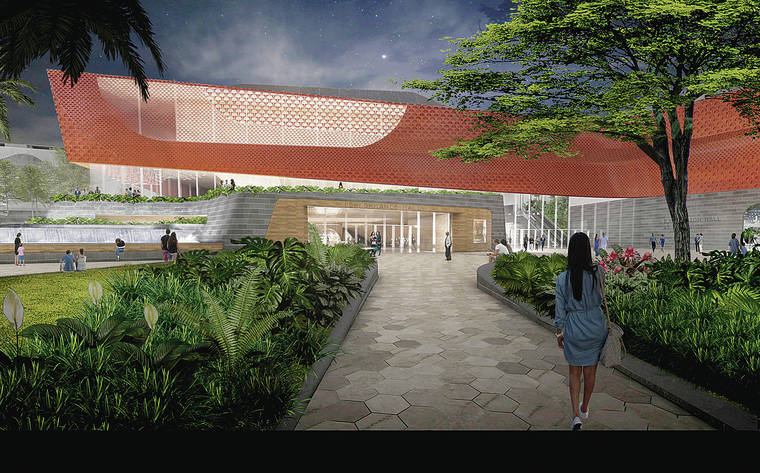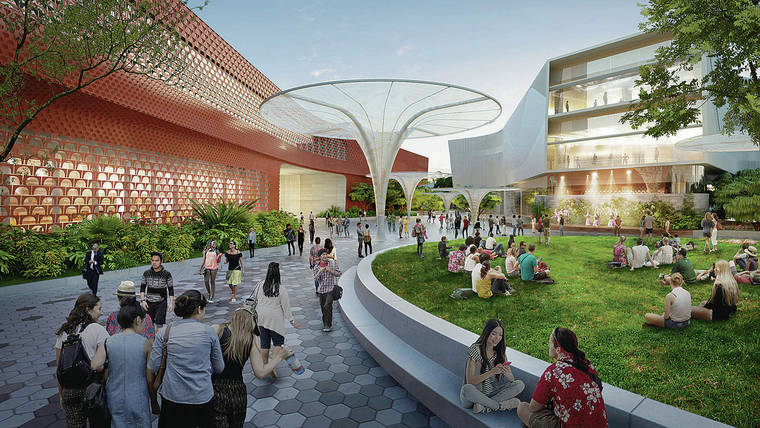New renderings showing a dramatically redeveloped Neal S. Blaisdell Center are being released by city officials this month as they begin selecting a private partner for the $772 million project.
The 22-acre Blaisdell campus, which first opened in 1964, would close in November 2020 for about three years, under the latest timeline presented by the city. The first work would be demolition of the existing arena, exhibition hall and parking structure, city Enterprise Services Director Guy Kaulukukui said Friday.
The basic concept of the Blaisdell Center Master Plan Opens in a new tab calls for the existing arena to be replaced by a nearly identical, clam shell-shaped, but modernized version; the exhibition hall to be demolished and replaced by an upgraded version as well as a 1,500-seat performance hall, an arts ensemble building and a satellite city hall; and the three-story parking structure to be replaced by two new parking facilities that could house about 500 more vehicles.
There would also be a new sports pavilion attached to the arena, and Victoria Street would extend to Kapiolani Boulevard, creating a true border with McKinley High School. The existing concert hall would be retained but receive significant upgrades.
Within the campus would be garden walkways, water features and five restaurants or bars.
The renderings were created following the release of the $4.8 million master plan, which was completed last year, Kaulukukui said. “We’re pretty comfortable that the final design is reflected in these renderings,” he said.
The city released its final environmental assessment Opens in a new tab for the project last month. Around the middle of this month, it will put out a call for potential private partners to submit information to show they qualify for the partnership arrangement, a process known as a request for qualifications, Kaulukukui said. The timeline calls for a partner to be selected by fall 2020, around the same time of demolition.
Response to a potential partnership has been good so far, he said.
The Caldwell administration sought $24 million in this year’s capital improvements budget for demolition work, but the City Council chopped that amount in half, Kaulukukui said. The administration hopes to get the rest of the money next year, he said.
Councilwoman Ann Kobayashi has been a critic of a Blaisdell redevelopment plan since Mayor Kirk Caldwell first proposed it several years ago. The move to a public-private partnership financing arrangement hasn’t persuaded her otherwise.
“I don’t know if we should be taking on this project when we have that big, looming project in front of us — rail, and they’re still working on public-private partnerships for that,” Kobayashi said. The 20-mile, East Kapolei-to-Ala Moana Center project has seen its price tag blow up to $9.2 billion from $5.26 billion several years ago.
“We should get a handle on that project before we begin another large project,” Kobayashi said. “I’m really worried about the rail project — the future of it and the maintenance of it. We have to focus on all the issues we have before us now.”
Caldwell noted that in 1964 the then-Hawaii International Center replaced the much smaller Honolulu Civic Auditorium in Pawaa at a cost of about one-fourth the annual city operating budget at that time. The price tag for the Blaisdell overhaul is also roughly one-quarter the cost of the city’s operating budget.
“It’s something we absolutely need to do, and it shouldn’t be delayed because the cost of construction continues to go up no matter what we do,” Caldwell said. “It’s going to cost us quite a bit to just maintain it in its current condition. … We can spend a couple hundred million to fix it up, or we can spend, through a public-private partnership, maybe $775 million to get a brand-new project that’s going to serve the people of the City and County of Honolulu for another 50-60 years.”
The $772.8 million estimated price tag includes overhead, fees and contingency, and actual construction is $547.6 million, Kaulukukui said.
Kaulukukui said he’s also heard objections from those who argue that it’s not a good time to undertake the Blaisdell redevelopment.
“My position is that you could pick a year — last year, next year, two years from now — and the argument would be the same thing, that it’s expensive, why do we do it now?” he said.
“And I think that’s how the state ended up with the situation at Aloha Stadium. For years, if not decades now, they’ve asked themselves, Is this the year we do something significant? As an administration we decided that this is the time, this is the year.”
Kaulukukui said city officials held three large workshops and more than a hundred small-group discussions with the public about the project. The Department of Land Management is required to hold an additional public hearing on the master plan concept before a partnership is approved, he said.
For more on the project, go to imagineblaisdell.com Opens in a new tab.






